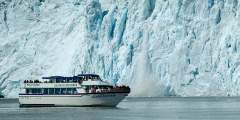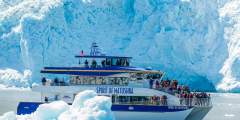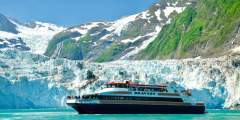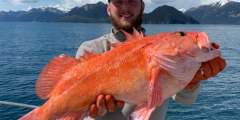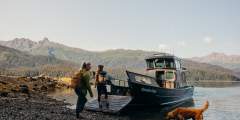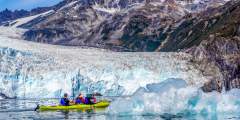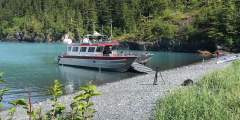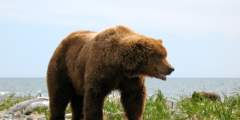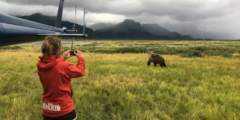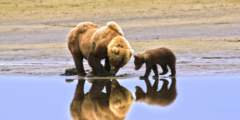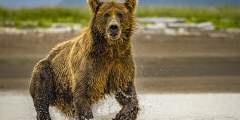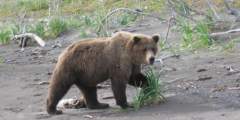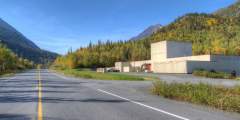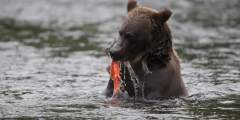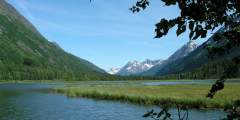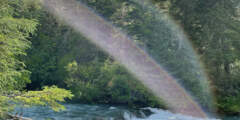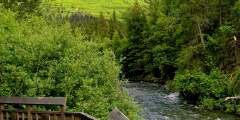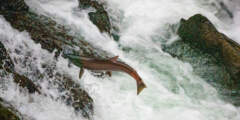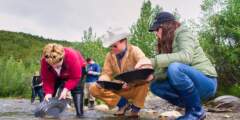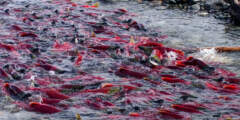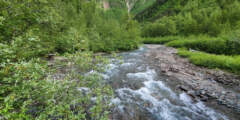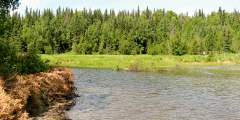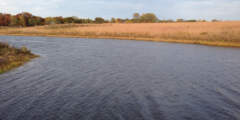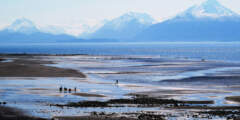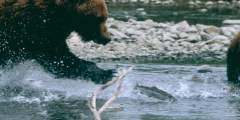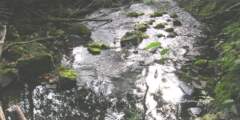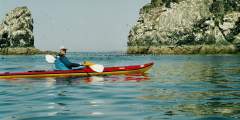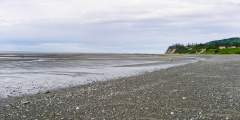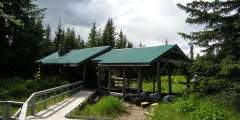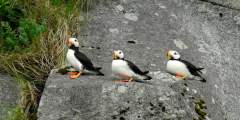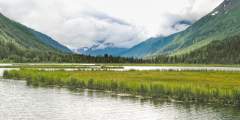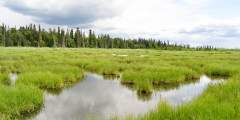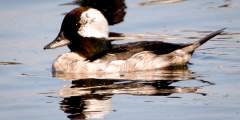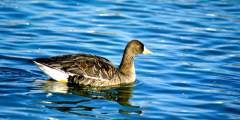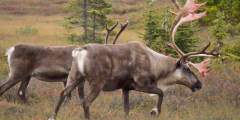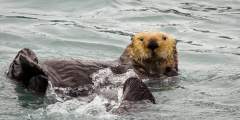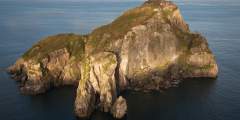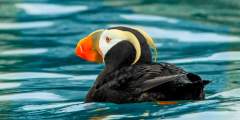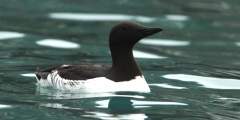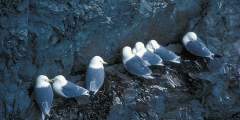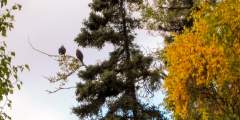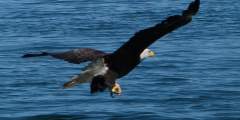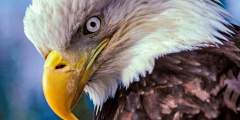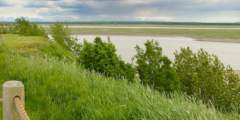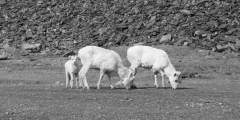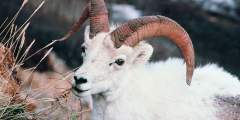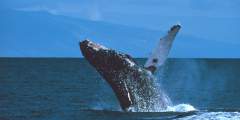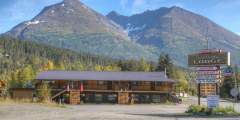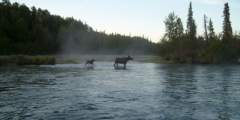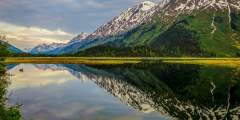The Best Wildlife Viewing Spots on the Kenai Peninsula
Show Map
Best Wildlife Viewing Spots on the Kenai Peninsula
Kenai Peninsula Day Cruises
This veteran tour operator runs a a fleet of fast, modern boats in Resurrection Bay and Kenai Fjords National Park. You’ll visit tidewater glaciers as you watch for puffins, sea otters, Dall’s porpoises, sea lions, and more. Some tours are designed to please birders or shutterbugs, while others are perfect for families.
Resurrection Bay and Kenai Fjords are great places to see wildlife and glaciers. And Major Marine’s vessels, which have cozy heated cabins and an outdoor viewing area, can take you out to see both. This family-owned tour operator has gone above and beyond to give guests an amazing day on the water since 1990.
Phillips 26 Glacier Cruise, out of Whittier, will take you to 26 different glaciers in just 5.5 hours. Enjoy cozy comforts on the high-speed catamaran and wander its outdoor decks as you come within 300 feet of massive tidewater glaciers. In addition to glaciers, the captain will be on the lookout for wildlife like otters, whales, harbor seals, and marine birds. The trip takes place in the afternoon, and a hot lunch is included in your tour. ...more
Homer is the halibut capital of Alaska, and this longtime charter company offers a blue-chip way to get to the fish. They have high-quality boats, experienced captains, and enthusiastic crews — as well as an inside line on finding halibut, rock fish and silver salmon. But they also offer a variety of other ways to enjoy the waters off Kachemak Bay, from wildlife cruising to paddling a kayak or hiking in Kachemak Bay State Park.
Whether you’d like to go on a personalized boat tour of the Homer area or take a water taxi to the Alaskan backcountry, Homer is an ideal place to launch from, and Coldwater has the boats and expertise to get you there. Explore places like Kachemak Bay State Park, the small town of Seldovia, and picturesque Halibut Cove.
Get up close to the Alaskan glaciers and wildlife you came to experience by taking a cruise into Kenai Fjords National Park on a custom-built catamaran out of Seward. The difference from other cruises, is that you’ll then get off the boat and into a kayak, paddle around icebergs, and watch for wildlife from your own vessel.
Lazy Otter offers classic tours, but this is a water taxi, so they’ll also take you anywhere you want to go within Price William Sound — or just customize a tour to whatever you want to see. Maybe that’s glaciers, or whales, — or maybe it’s quiet time on a secluded beach. Lazy Otter can also help facilitate taking you and your family on a camping trip. You’re not held to any strict schedule, either: if, on a day tour, you can spend more time in one ...more
Bear Viewing Tours
Watch bears digging for clams, wandering the sedge grass, or nursing their young – all in a short flight from Homer to Katmai or Lake Clark National Park. Smokey Bay’s bear tours last about five hours total — including flights and about three hours on the ground. On any given day there will always be a morning outing (leaving at 8 a.m. at the latest) and possibly one that leaves around 2 p.m.
For many Alaskan travelers, bears are the ultimate highlight. Pair a magnificent sighting with a gorgeous helicopter flightseeing ride and you’ll have an unforgettable experience. On this unique tour from Homer, you’ll take a helicopter ride out into one of Alaska’s gorgeous national parks to witness these spectacular creatures in the wild.
Spend several hours or a full day watching bears in the wild on a quintessential Alaskan adventure with a family-run company. Start with a scenic flight out of Homer over Kachemak Bay and into Katmai or Lake Clark National Park. Once you land, your pilot/guide will take you to an optimal spot to watch and photograph these magnificent creatures in their natural environment, hunting, playing, and relaxing. Spend anywhere from 1.5 to 9 hours on the ...more
In the best way possible. you’re outnumbered by bears during your stay at this private fly-in wilderness camp. Fly by chartered plane from Homer to Alaska Bear Camp on a 5‑night, 6‑day all-inclusive package. This deluxe backcountry camp accommodates just 14 guests in some of the best bear habitat in the world. In contrast to day trips catering to dozens of visitors at a time, Bear Camp offers a rare and exclusive wilderness immersion.
Fly out of Soldotna with Natron’s owner and pilot, Tim. You’ll soar over the Cook Inlet towards Mt. Iliamna Volcano and land on a beach, right where the bears are. You’ll watch them playing and clamming and be close enough to take amazing photos.
Salmon Viewing Spots
Learn how the fish are raised from small alevin to fry and beyond to smolt size before being released into surrounding lakes and bays. Depending on the fish cycle, there may or may not be fish to view, so please call ahead. If there are no fish to be seen, you’re welcome to look at a small photo gallery and learn about the fish production cycle, and understand why hatchery’s play such an important role in keeping our fish population… ...more
This wildlife sweet spot is worth a visit. The Russian Lakes Trail begins off the access road to the Russian River Campground in Cooper Landing, at milepost 52 of the Sterling Highway. Get off-the-beaten path, hike two miles to the falls and enjoy the immediate reward of spectacular salmon viewing.
This is a day use site that offers 13 picnic sites with tables, a fish viewing platform, water, toilets, an information board, and fire grates.
Great sockeye salmon observation site, especially in late July and early August. At other times of year it offers a moderate walk up to Ptarmigan Lake that’s great for families and features lots of bird life.
This salmon viewing location includes an all-acccessible viewing platform overlooking the creek as well as viewing opportunties along Ptarmigan Creek trail. Sockeye salmon will be in the creek from late July to early October with the best viewing in mid-August. Vehicle parking is in the day use area inside Ptarmigan Creek Campground.
Viewing is easy due to the all-acccessible viewing platform and streamside trail. Sockeye, chum, pink, and silver salmon will be visible August — November
Look for the Russian River Campground (entry fee required) and park in the day-use parking areas within campground facilities. A two mile well-maintained gravel trail leads to the viewing platform above the falls or to the angler trail along the river. Use caution for high densities of brown and black bears who are fishing for the same Sockeye and Coho salmon you are looking for. Salmon are in the river mid June through September with the… ...more
From the gravel pullout on the west side of the highway, an easy 1⁄4 mile walk to the Sockeye salmon viewing platform awaits (not fully accessible). Salmon are in the creek from mid-July to early August with the best viewing in late July.
Sounds Wild: Trees Need SalmonAs you drive toward Soldotna you will see the Kenai River on your left. This river has thousands of salmon spawning in it each year. Mostly sockeye or red salmon but also coho or silver salmon, chinook or king salmon and pink or humpy salmon. After these salmon die, they float downstream and are deposited along the riverbank where they decompose and provide food to the riverside plants.More Information ...more
Turn on Quartz Creek Road and proceed 2 miles to Quartz Creek Campground. The stream is adjacent to the picnic area and a trail expands Sockeye and Coho salmon viewing opportunities upstream or downstream. Salmon viewing takes place from late July to early October with best viewing in early August.
Slikok Creek passes under Kalifonsky Rd. and fish can be seen spawning near the culvert on both sides of the road. This is a critical habitat area and you are asked not to wander along the banks of this very sensitive stream. All viewing can be done next to the road. Best salmon viewing months are June and early-July.
Walk out to the boardwalks along the Kenai River, learn about riverine habitat and the salmon lifecycle, and witness the timeless dance of hunter and hunted, of fish and fisher. One year-round resident here will impress you with their winter survival skills.
Izaak Walton State Rec Site near Sterling offers 31 campsites at the junction of the Kenai and Moose Rivers on Alaska’s Kenai Peninsula. Managed by Alaska State Parks, it features spruce surroundings, river access, a boat launch, vault toilets, and fire rings. Named after famed angler Izaak Walton, it’s ideal for salmon fly-fishing, exploring archaeology, and enjoying the Kenai’s scenic beauty.
The trail is half a mile long and takes you through a mature birch forest that is carpeted with devil’s club and watermelon berry plants. It’s an easy walking, ideal for small children, and ends at a small camping area on a slight bluff that overlooks Bishop’s Beach and Bishop Creek.
This spot in Sterling — at milepost 82.3 at the Isaak Walton Campground — is where the Moose River meets the Kenai River, and the two rivers’ differing paces are drastic. The Moose River is very slow and wide, with almost no current — so much so that it feels more like a lake. The Kenai River, on the other hand, flows fairly swiftly in comparison, and the confluence can play strange tricks on your tackle.
The salmon lifecycle and a working salmon-counting operation is on the menu here, as well as a fresh salmon for your dinner, if you time your visit just right. Hear how!
Grouse Creek runs adjacent to the Seward Highway. To access this creek, exit onto the paved pullout at mile 8.3. There’s a Chugach National Forest sign here too that marks the spot. From late- July to mid-September, you will be able to view sockeye salmon with the best chance of seeing fish in mid-August.
Birding Spots
From the base of the Homer Spit, take this 4‑mile paved trail to the Nick Dudiak Fishing Lagoon. The trail is in excellent condition and is flat as a pancake for most of its length. The first mile of trail is along a broad estuary that is great for birding. Once you pass the one-mile mark you’ll be riding past fishing boats that are out of the water being worked on as well as a few shops.
Sounds Wild: Ravens HotWherever there is food, you will find ravens and northwest crows. In fact crows love people and their food. At the Homer Small Boat Harbor you can find these birds feeding along the shore, in the campgrounds and perched on the surrounding telephone poles and buildings.More Information
To all the other great reasons to visit Homer, add plentiful shorebirds, seabirds, marine mammals, and a ring of stunning mountain peaks surrounding Kachemak Bay. The Islands and Ocean Visitors Center puts the icing on this cake.
More than 20,000 birds often nest on the cliff faces of this craggy island in Kachemak Bay about three miles south of the Homer Spit. See thousands of screaming kittiwakes, babies crying from nests, murres and puffins and other seabirds diving offshore for fish, lone bald eagles on the hunt for a meal.
Sounds Wild: Underground SeabirdsA great spot on the Kenai Peninsula to see a large group of seabirds nesting is Gull Island out of Homer. This short three-mile boat ride across Kachemak Bay is great for families. You’ll also find red-faced cormorants, common murres, puffins, eagles, murrelets, sea otters, harbor seals, sea lions and even whales.More Information ...more
Sounds Wild: PhalaropesHundreds of red-necked phalaropes can be seen from the end of the Homer Spit during their spring and fall migrations. Look for these small birds spinning in circles on the water. They do this to concentrate food. These whirling living tops are a joy to watch. They tend to be in small flocks, which can make spotting them easier.More Information ...more
Everyone wants to explore a tidepool, don’t they? This is a must for the kids — even that little kid in those slightly more mature visitors. Here’s the perfect spot. Bring a towel and let’s have an intertidal adventure.
At Homer’s main traffic light, at Lake Street and the Sterling Highway, be sure to stop on the south side of the road and look up — way up. You’ll likely get a glimpse of a big, messy eagle’s nest at the top of a dead spruce there, where in late summer you might even see fluffy, rumpled baby eagles peeping over the top. Look one tree over, too, to see if you can spot one of the parents standing guard.If you don’t see the nest on the day you’re… ...more
Above Homer, up East Hill and right on Skyline Drive a mile and a half (a beautiful drive along the bluffs overlooking Homer), watch for the Wynn Nature Center, managed by the Center for Alaskan Coastal Studies. You can stroll in the wilderness among the beautiful flora and watch for wildlife or take a tour guided by a well-informed naturalist.
As you drive out East End Road about 4 miles you will see open fields, and likely the sandhill cranes that frequent them.
Witness giant tractors towing the Kenai Peninsula’s fleet out to water’s edge and launching them into the tide on their quest for fish. You can camp here, scout for wildlife, fish for steelhead, and enjoy some of the best puffin viewing on the Kenai.
Sounds Wild: LoonsAs you approach Summit Lakes, look for common loons. Most of the time they are found at the southern end of the lakes near the shore but can be anywhere, so stop at the lodge and road pullouts to look at the lake surface. Moose can sometimes be seen in the marsh areas at the end of the lakes.More Information
Sounds Wild: Birds SmellTern Lake has lots to offer but few people use the old Sterling highway to access the boreal forest near this lake. Drive into the recreational area and as you turn left toward the restrooms you will see an old road to your right. You can walk for miles down this road and enjoy the smell of the woods and the sound of the birds.More Information ...more
Located at the intersection of the Seward and Sterling highways at Milepost 37. This area hosts a myriad of animals, birds, fish, and unique plants. Common loons, bald eagles, and arctic terns share the area with a variety of songbirds and shorebirds like the northern water thrush, golden-crowned sparrow, and the greater yellowlegs. Beavers, river otters, muskrats, and salmon ply the cold, clear waters of Tern Lake. Moose, Dall sheep, and… ...more
You’ll either enjoy a peaceful walk through a secluded and beautiful estuary ripe with birdlife — or have a ringside seat at the annual salmon dipnetting extravaganza, featuring hordes of crazed locals armed with 10-foot poles. The beach road emerges from the forest at a river-mouth lined by dunes, tidally influenced beach, an estuary and broad salt marsh.
Definitely keep your eyes open here, there’s volcanoes, beluga whales, harbor seals, and tons of birdlife to be seen — depending on the season and weather, of course. Extra credit if you spot an owl!
Sounds Wild: Porky BabiesPorcupines are not often seen along the main paved roads of the Kenai Peninsula. You have to get off on the gravel side roads that pass through their habitat. Tustumena Lake road travels through the Kenai Wildlife Refuge and ends at the Kasilof River campground. This road is great for viewing various birds including spruce grouse, thrushes and chickadees. Moose are found along this road and if you are really lucky, a… ...more
Stretch your legs here and check out one of the favorite rest stops for thousands of Kenai River salmon on their journey home. We’ll also seek out giant trumpeter swans, red-necked grebes, and of course, fishers of another species — humans. Here at the confluence, the two rivers reveal their source waters in a very clear visual demonstration.
Not Steinbeck’s classic novel, but a fantastic adventure, communing with a 30,000-member herring gull colony. It’s a one-of-a-kind experience you won’t want to miss.
Let’s go caribou-spotting on the wide open spaces at the mouth of the world-famous river system. This spot is one of your best bets for viewing these beautiful, stately beasts.
Walk out to the boardwalks along the Kenai River, learn about riverine habitat and the salmon lifecycle, and witness the timeless dance of hunter and hunted, of fish and fisher. One year-round resident here will impress you with their winter survival skills.
Sounds Wild: Alaska’s DragonsWatson Lake is a shallow lake that is full of vegetation – just the right spot for dragonflies and other critters. Standing at the boat launch and camping area, look out across the lake for these large flying insects. Red-necked grebes, rusty blackbirds and loons are also found on the lake. Most lakes on the Kenai Peninsula can be a good spot for dragonflies.More Information ...more
Sounds Wild: Mother BatsThis recreational site has a series of loop trails that pass two small lakes. Park in the parking lot and take the path to your left as you face the buildings; this will lead you to the trailhead. The trail is great for viewing woodland birds and loons on the lake. As evening approaches, look for bats flying over the lake feeding on insects. Bats are hard to see because they are very secretive and do not become active… ...more
Sounds Wild: SparrowsSavannah sparrows love to sing and hide in the grass. However, sometimes they will perch on a fence, small trees or brush piles in this estuarine area. Walk along the beach toward the Kasilof River and look at the large flats to your right. In addition to sparrows you will see arctic terns, numerous herring, mew gulls and migrating shorebirds in the spring and fall.More Information ...more
Just south of Seward you could spot humpback whales, sea lions, bird life and old growth forest habitat. There’s a great sand beach at the end that will reward your exploration, so let’s go!
As the boat pulls away from the nesting areas of the horned puffins it will turn left and again stay right next to the cliff face. You’ll notice some pelagic and possibly red-faced cormorants nesting high on the cliff just after the boat turns to the left for the final stretch of Cape Resurrection.
Here is the local favorite area of our Horned and Tufted puffins. You can tell the two species apart if you remember that “Tough Guys Wear Black.” The tufted puffin’s body is entirely black with distinctive long yellow “tufts” of feathers on either side of their head. Horned puffins have a white belly and black back. These puffins come to land only to lay their eggs and raise their young. Puffins spend most of their lives about 400 miles away… ...more
Some of the little caves on the tip of the cape contain nesting Common murres. You may also be seeing many of these murres on the water. They have black heads, black backs and white bellies. They are Alcids, like the puffins, so they are diving birds that use their wings for propulsion under water. Of all the alcids, common murres can dive the deepest, plunging to record depths of at least 600 feet.In addition to the cave nesters on the Cape,… ...more
Up ahead the noise and odor of the Black legged Kittiwakes will soon become apparent. These birds take advantage of the slight depressions in the rocks to build their nests. Their nest is simply some grass and mud glued to the rock wall with their own guano. These birds nest in dense aggregations as a means of protection against birds of prey.If a Bald eagle or Peregrine falcon flies into the area every bird will leave the rocks in one… ...more
Just up ahead on the right is a small rock that sticks above the water and almost always has a mixed group of cormorants standing atop it drying out their feathers. This long necked black bird dives in the water and uses its feet to swim but unlike the puffins and other alcids has no oil in its feathers to aid in drying off. So they stand out on rocks to get dry.Just up ahead on the left you will see a rock with many gulls on top of it and… ...more
Eagle Viewing Spots
At the Seward Small Boat Harbor look out at the rock jetties and buoys. Eagles like to sit on these spots and monitor their domain. Food is also plentiful from fisherman cleaning fish, seabirds that stay in the area and fish that return to the streams nearby.
This is an easy place to watch an active eagle nest in the top of a spruce tree. There had been a nest prior to this one in a dead spruce but it fell in a past winter storm. The eagle pair quickly built this new nest a short distance away in a live spruce. If you have time to watch, you may see the parents bringing in food for the youngster. There is a lot of activity at this nest and it is s great place to get good photographs of… ...more
Sounds Wild: AltricialFor many years an elderly lady fed eagles at this spot during the winter months: “The Eagle Lady of Homer Spit.” Her house was right on the beach and she received fish waste from a local fish processor, which she would then give to the hundreds of eagles that would show up for their daily feeding. After she passed away this practice of feeding the eagles was stopped.More Information ...more
Everyone wants to explore a tidepool, don’t they? This is a must for the kids — even that little kid in those slightly more mature visitors. Here’s the perfect spot. Bring a towel and let’s have an intertidal adventure.
The spit has a reputation for attracting decent numbers of America’s national bird — drawn by myriad potential food sources from fishermen, seafood processing and a vast beach with a big tidal range and crashing surf.
Definitely keep your eyes open here, there’s volcanoes, beluga whales, harbor seals, and tons of birdlife to be seen — depending on the season and weather, of course. Extra credit if you spot an owl!
The trail is half a mile long and takes you through a mature birch forest that is carpeted with devil’s club and watermelon berry plants. It’s an easy walking, ideal for small children, and ends at a small camping area on a slight bluff that overlooks Bishop’s Beach and Bishop Creek.
At the Soldotna dump you can sometimes see several hundred eagles at once.
Sounds Wild: Eagles Lifetime MatesWant to see a soaring eagle up close? Stop at this site near the senior center and walk out toward the bluff – not too close as the bluff is eroding. Eagles play in the wind along the bluff. If not flying they can be seen on the mud flats at low tide– looking for food that has washed downstream.More Information ...more
Stop off here during the summer for an eagle’s eye view of an annual Alaskan fishing frenzy. We really love our salmon, and it shows! Or, just count the bald eagles circling high overhead.
Deep Creek South Campground, near Ninilchik on Alaska’s Kenai Peninsula, offers 100 wooded sites with access to Deep Creek and Cook Inlet. Managed by Alaska State Parks, it features beach and river access, vault toilets, and fire rings. This spacious campground is ideal for salmon fishing, beachcombing, or enjoying coastal views, with Ninilchik’s historic charm just minutes away.
Deep Creek North Campground, at Mile 137.3 of the Sterling Highway near Ninilchik, offers 100 wooded sites with river and Cook Inlet access. Managed by Alaska State Parks, it features vault toilets, interpretive displays, and a spruce setting. It’s a cozy base for salmon fishing, enjoying scenic viewpoints, or exploring the coastal beauty, with Ninilchik’s historic charm just minutes away.
Stop here for a view of the Ninilchik River and watch for bald eagles which often soar along the river. You’ll also find walking paths and an interpretive information sign about the area.
Sheep & Mt. Goat Viewing Spots
The western coast of outer Resurrection Bay near Seward offers the state’s best opportunity to see wild goats up close, with animals often perched on ledges just above the sea — making the area a popular destination during marine wildlife cruises out of Seward.
A popular stop for wildlife viewing, this shallow, productive lake in the Kenai Mountains nestles between two immense faces that rise 3,000 to 4,000 feet above the valley floor. The slope to the northeast sometimes draws both mountain goats and Dall sheep into the open, one of the few places where both species overlap.
Whale Watching Spots
Definitely keep your eyes open here, there’s volcanoes, beluga whales, harbor seals, and tons of birdlife to be seen — depending on the season and weather, of course. Extra credit if you spot an owl!
Another marine mammal you may encounter during this part of the trip is the Dall’s porpoise. This animal is spotted when a repeating splash pattern is seen on the surface of the water. The splash is called a “rooster tail” and is created by the dorsal fin of the animal cutting through the water at high speeds. The Dall porpoise can swim at least 35 mph and easily pass this boat. However, often times the porpoise will travel with the boat for a… ...more
Just south of Seward you could spot humpback whales, sea lions, bird life and old growth forest habitat. There’s a great sand beach at the end that will reward your exploration, so let’s go!
Once we leave Barwell Island the boat is as far out into the ocean as it gets. This is a good place to look for whales. Humpback and Orca whales (killer whales) are the most likely to be spotted. Humpbacks are found by the ten foot tall cloud of mist that is formed when they exhale clearing their blowhole. The obvious feature of the orca whale is its black dorsal fin penetrating the surface. Male orca whales have a six foot high fin. Whale… ...more
Sounds Wild: Thar She BlowsWhales, dolphins, sea otters, harbor seals and sea lions are all visible in Kenai Fjords National Park. While you might see some of these animals from shore, the best option is a day cruise out of Seward. A number of companies offer these services and you will not be disappointed. Glaciers and birds top the list.More Information ...more
Caribou Viewing Spots
Sounds Wild: Caribou Caribou can be seen anywhere on the Kenai River estuarine area but are more frequently seen on the east side of the Bridge Access Road. They have their calves here in the spring and feed the rest of the summer and fall. They are commonly seen but there are no guarantees with caribou. More Information
Sea Lion Viewing Spots
In the water, there is a triangularly shaped large rock with a smaller triangular rock in the water to its right. Atop this smaller rock we hope to find a group of the Steller sea lions. If we do not spot them here, they will be a little further south on the beach. Look for various sizes and colors of animals. Dark grey animals have just left the water, brown or tan animals have been out a while and are dryer. Fully grown males have a very… ...more
Moose Viewing Spots
Located on the shores of Upper Trail Lake, the town is surrounded by the Chugach National Forest and is also home to the start of the Iditarod trail, which was blazed through here in 1910. Since it seems to be just a dot on the road, though, it would be easy to miss — but it makes a great home base for visiting Seward or the Russian River fishing area.
Sounds Wild: Pond-Bottom MooseThe wetlands where the Kenai Spur Highway crosses Beaver Creek are great for viewing moose in the early morning or late evening. Like most streams on the Kenai Peninsula, the streamside vegetation consists of willows- a favorite food of moose. Look to your right as you head toward Kenai and check out all the wetland areas for the next couple of miles.More Information ...more
The Kenai River meanders through a sweeping salt marsh and wetland on its final five-mile journey to its mouth on Cook Inlet. While more well known for its immense flocks of migrating birds and the presence of a small herd of caribou, the estuary also draws moose into the open.
Wildlife regularly converges on this shallow and very productive lake surrounded by big, open slopes in the heart of the Kenai Mountains. Famous for attracting waterfowl and migrating birds,Tern Lake also draws moose to the boundaries between meadows and forest, especially early and late in the day.

